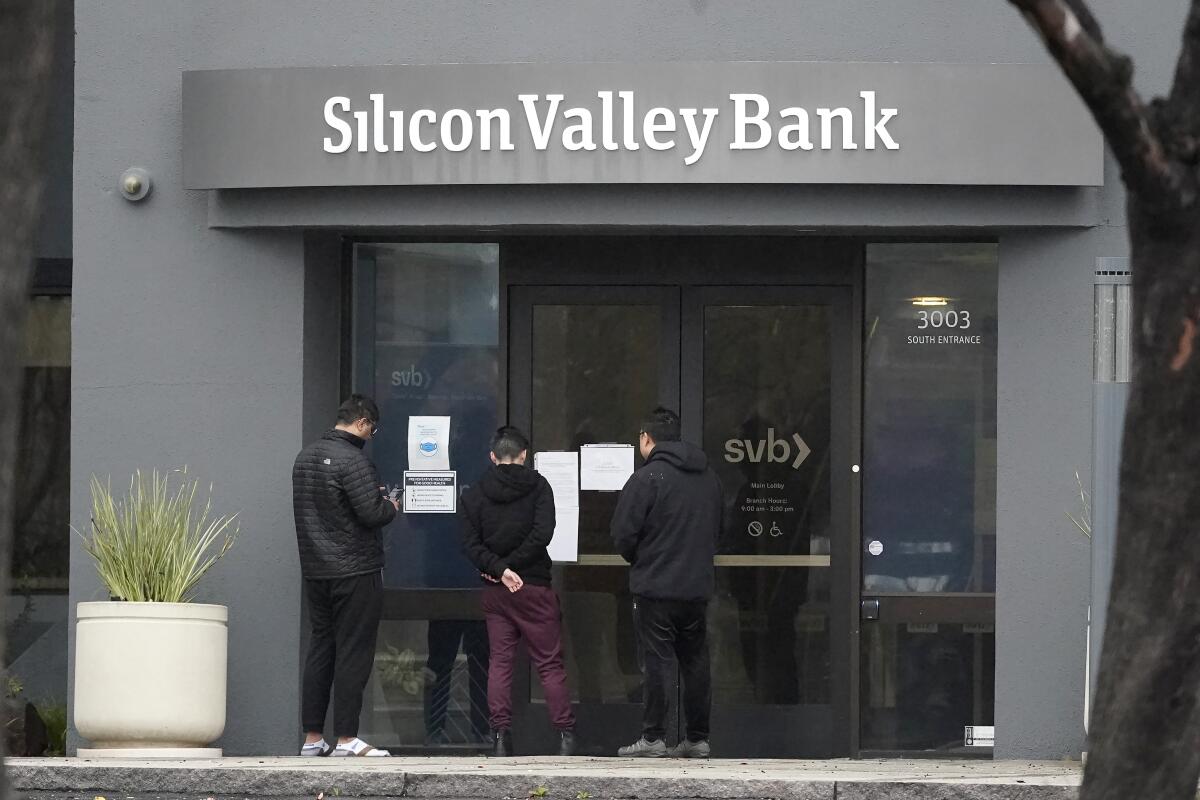Silicon Valley Bank collapses in biggest failure since 2008

- Share via
Silicon Valley Bank became the biggest U.S. lender to fail in more than a decade after a tumultuous week that saw an unsuccessful attempt to raise capital and a cash exodus by the tech startups that had fueled the lender’s rise.
Regulators stepped in and seized the Santa Clara, Calif.-based bank Friday, a stunning downfall for a lender that had quadrupled in size over the last five years and was valued at more than $40 billion as recently as last year.
The move by California state watchdogs to take possession of the bank, known as SVB, and appoint the Federal Deposit Insurance Corp. as receiver adds to the turmoil at smaller lenders caused by rapid interest rate increases in the U.S. and other disruptions.
Just days earlier, Silvergate Capital in La Jolla announced it was shutting down its bank, spurring a broader selloff in industry stocks.
Banks were already suffering from the jump in rates that eroded the value of their portfolios, and meanwhile customers in the technology and crypto startup worlds were yanking cash amid a slump in their businesses. In SVB’s case, the turmoil fed on itself as customers worried about its health rushed to withdraw money.
“Bank runs are a lot about psychology. And at this point, it’s very rational to be nervous,” said Saule Omarova, a law professor at Cornell University.
In Washington, the situation prompted a series of discussions among top regulators.
Treasury Secretary Janet Yellen called a meeting Friday with leaders from the Federal Reserve, the FDIC and the Office of the Comptroller of the Currency to discuss developments around SVB. Yellen said in a statement that the U.S. banking system “remains resilient” and regulators “have effective tools” to address the fallout.
The government is assessing whether it can sell SVB, or parts of it, by Monday, said a person familiar with officials’ conversations, who asked not to be identified speaking about internal deliberations. That’s the day when customers can come to the bank and start taking out the rest of their money.
Treasury representatives didn’t immediately respond to an emailed request for comment.
Problems mounted for the bank after Peter Thiel’s Founders Fund and other high-profile venture capital firms advised their portfolio companies to pull money from SVB. The calls followed parent company SVB Financial Group announcing that it would try to raise more than $2 billion after a significant loss on its portfolio.
The FDIC said that SVB’s insured depositors would have access to their funds by no later than Monday morning. Uninsured depositors will get a receivership certificate for the remaining amount of their uninsured funds, the regulator said, adding that it doesn’t yet know the amount. In announcing the takeover, the California Department of Financial Protection and Innovation cited inadequate liquidity and insolvency.
Receivership typically means a bank’s deposits will be assumed by another, healthy bank, or the FDIC will pay depositors up to the $250,000 insured limit.
“The FDIC receivership will end the uncertainty about this particular bank,” Omarova said. le Omarova, “But I don’t think that necessarily itself stops people from feeling less safe if they have some kind of exposure to assets or they hold their own money in banks with similar risk profiles.”
SVB Financial Group is in talks to sell itself after attempts to raise capital amid a bank run failed, CNBC reported.
SVB was founded in 1983 over a poker game between Bill Biggerstaff and Robert Medearis, according to a statement from the bank’s 20th anniversary. Since its start, the firm has specialized in providing financial services to tech startups.
U.S. regulators arrived at the California offices of SVB as the troubled lender struggled to stabilize its finances on Thursday, Bloomberg News reported.
The bank had about $209 billion in total assets and about $175.4 billion in total deposits at the end of last year, the FDIC said Friday.
Bloomberg writer Max Reyes contributed to this report.
More to Read
Inside the business of entertainment
The Wide Shot brings you news, analysis and insights on everything from streaming wars to production — and what it all means for the future.
You may occasionally receive promotional content from the Los Angeles Times.











